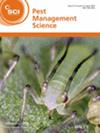求助PDF
{"title":"Methyl jasmonate induced tolerance effect of Pinus koraiensis to Bursaphelenchus xylophilus","authors":"Qiaoli Chen, Jiawei Zhang, Lingfang Ye, Nian Liu, Feng Wang","doi":"10.1002/ps.8407","DOIUrl":null,"url":null,"abstract":"BACKGROUNDMethyl jasmonate (MeJA) can affect the balance of hormones and regulate the disease resistance of plants. Exploring the application and mechanism of MeJA in inducing the tolerance of <jats:italic>Pinus koraiensis</jats:italic> to pine wood nematode (PWN) infection is of great significance for developing new strategies for pine wilt disease control.RESULTSDifferent concentrations (0.1, 1, 5 and 10 m<jats:sc>m</jats:sc>) of MeJA treatment groups showed differences in relative tolerance index and relative anti‐nematode index of <jats:italic>P. koraiensis</jats:italic> seedlings to PWN infection. The treatment of 5 m<jats:sc>m</jats:sc> MeJA solution induced the best tolerance effect, followed by the 1 m<jats:sc>m</jats:sc> MeJA solution. Transcriptome analysis indicated that many plant defense‐related genes upregulated after treatment with 1, 5 and 10 m<jats:sc>m</jats:sc> MeJA solutions. Among them, genes such as <jats:italic>jasmonate ZIM domain‐containing protein</jats:italic>, <jats:italic>phenylalanine ammonia‐lyase</jats:italic> and <jats:italic>peroxidase</jats:italic> also continuously upregulated after PWN infection. Metabolome analysis indicated that jasmonic acid (JA) was significantly increased at 7 days postinoculation with PWN, and after treatment with both 1 and 5 m<jats:sc>m</jats:sc> MeJA solutions. Integrated analysis of transcriptome and metabolome indicated that differences in JA accumulation might lead to ubiquitin‐mediated proteolysis, and expression changes in trans‐caffeic acid and trans‐cinnamic acid‐related genes, leading to the abundance differences of these two metabolisms and the formation of multiple lignin and glucosides.CONCLUSIONSMeJA treatment could activate the expression of defense‐related genes that correlated with JA, regulate the abundance of defense‐related secondary metabolites, and improve the tolerance of <jats:italic>P. koraiensis</jats:italic> seedlings to PWN infection. © 2024 Society of Chemical Industry.","PeriodicalId":218,"journal":{"name":"Pest Management Science","volume":null,"pages":null},"PeriodicalIF":3.8000,"publicationDate":"2024-09-11","publicationTypes":"Journal Article","fieldsOfStudy":null,"isOpenAccess":false,"openAccessPdf":"","citationCount":"0","resultStr":null,"platform":"Semanticscholar","paperid":null,"PeriodicalName":"Pest Management Science","FirstCategoryId":"97","ListUrlMain":"https://doi.org/10.1002/ps.8407","RegionNum":1,"RegionCategory":"农林科学","ArticlePicture":[],"TitleCN":null,"AbstractTextCN":null,"PMCID":null,"EPubDate":"","PubModel":"","JCR":"Q1","JCRName":"AGRONOMY","Score":null,"Total":0}
引用次数: 0
引用
批量引用
茉莉酸甲酯诱导柯来松对嗜木毛刺蝠的耐受效应
背景茉莉酸甲酯(MeJA)可以影响植物体内激素的平衡,调节植物的抗病性。结果不同浓度(0.1、1、5 和 10 mm)的 MeJA 处理组对松材线虫感染的相对耐受指数和相对抗线虫指数均有差异。5 mm MeJA溶液的耐受效果最好,其次是1 mm MeJA溶液。转录组分析表明,用 1、5 和 10 mm MeJA 溶液处理后,许多植物防御相关基因上调。其中,含茉莉酸 ZIM 结构域蛋白、苯丙氨酸氨解酶和过氧化物酶等基因在感染 PWN 后也持续上调。代谢组分析表明,茉莉酸(JA)在接种 PWN 后 7 天以及用 1 毫米和 5 毫米 MeJA 溶液处理后显著增加。转录组和代谢组的综合分析表明,JA积累的差异可能会导致泛素介导的蛋白水解,以及反式咖啡酸和反式肉桂酸相关基因的表达变化,从而导致这两种代谢物的丰度差异,并形成多种木质素和葡萄糖苷。© 2024 化学工业协会。
本文章由计算机程序翻译,如有差异,请以英文原文为准。


